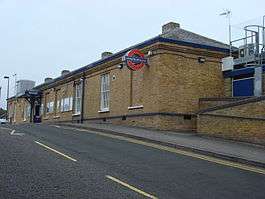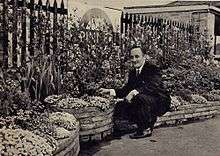Pinner tube station
Pinner is a London Underground station on the Metropolitan line in zone 5. The station was opened in 1885 as part of the Victorian expansion of dormitory suburbs, and was one of the stations included in the Metro-land project in the early 20th century. The site is served by several bus routes including links to the Hatch End railway station which was known as Pinner & Hatch End prior to 1920. Step free facilities were opened in 2008. Its adjacent stations are Northwood Hills (northbound) and North Harrow (southbound).
| Pinner | |
|---|---|
 The entrance to Pinner tube station on Station Approach. | |
 Pinner Location of Pinner in Greater London | |
| Location | Pinner |
| Local authority | London Borough of Harrow |
| Managed by | London Underground |
| Number of platforms | 2 |
| Accessible | Yes[1] |
| Fare zone | 5 |
| London Underground annual entry and exit | |
| 2014 | |
| 2015 | |
| 2016 | |
| 2017 | |
| 2018 | |
| Key dates | |
| 25 May 1885 | Opened[4] |
| 3 April 1967 | Goods yard closed[5] |
| Other information | |
| External links | |
| WGS84 | 51.5928°N 0.3806°W |
Since Pinner is not served by fast services, one should change at Harrow-on-the-Hill or Moor Park for an all stations or semi-fast Metropolitan line train in either direction. This change is only needed on Mondays-Fridays during peak hours only (southbound during the morning peak and northbound during the evening peak).[6]
History

The station was opened on 25 May 1885,[7] following a prior expansion to nearby Harrow-on-the-Hill station in 1880.[4] It remained the terminus of the Metropolitan Railway until 1 September 1887 when the line was further extended to Rickmansworth.[7] The long, single-story station building on the up (southbound) platform is the original building, and resembles the stations at Rickmansworth, Chorleywood and Chalfont & Latimer. The down platform buildings were built during the four-tracking project of the 1950s and 60s in a matching yellow brick.
In 1915, the Metro-land project was conceived in order to move people out of central London into rural Middlesex. Houses near the stations were built in haste and sold for as little as £400 each. However, in Pinner houses built during this expansion were required to be worth at least £1,000 – compared to Harrow-on-the-Hill where prices were subject to a £750 minimum.[8]
In 2009, a Pyrenean Mountain Dog named Rufus became a minor celebrity for his daily commute from Pinner to Baker Street due to his size. Rufus accompanies his owner, Michael Stavrides, as he travels to his art gallery in Marylebone. The dog received publicity following a debate began in the Daily Mail after he was described as "pony-like" and a person objected to his presence on the rush hour train.[9]
The station building on Station Approach is locally listed by the Harrow Council.[10]
Location
London bus routes 183, H11, H12 and H13 serve the station's location and provide services that terminate at Golders Green, Harrow, Mount Vernon Hospital, Northwood Hills, Ruislip, South Harrow and Stanmore.[11] The H12 route also connects Pinner tube station to Hatch End railway station, which was named Pinner & Hatch End between 1911 and 1920 before being renamed Hatch End (for Pinner) and then, in 1956, Hatch End.[12] Northwood Hills station is 2.08 kilometres (1.29 mi) to the north west and North Harrow is 1.48 kilometres (0.92 mi) to the south east on the Metropolitan line.[13]
Access to the southbound platform is step-free from the ticket hall. In order to reach the northbound platform, it is necessary to use a footbridge, which was constructed in 2002. Before this, a subway between the two platforms existed, but this was closed for safety reasons. Accessibility lifts opened on 18 July 2008 making the station totally step-free. Originally scheduled for installation in 2005, the delay had been caused by a lack of funding and was originally rescheduled for 2009/10 but following complaints by the Harrow Public Transport Users Association the construction was brought forward to 2007 only to be delayed by the collapse of London Underground contractors Metronet.[14]
Services
In the northbound direction off-peak the station is served by trains to Watford (4tph), Amersham (2tph) and Chesham (2tph) trains (at peak times, 'fast' trains do not stop at stations between Harrow-on-the-Hill and Moor Park). In the southbound direction off-peak services generally run 4tph to Baker Street and 4tph to Aldgate.
References
- "Step free Tube Guide" (PDF). Transport for London. May 2020. Archived (PDF) from the original on 7 August 2020.
- "Multi-year station entry-and-exit figures (2007-2017)" (XLSX). London Underground station passenger usage data. Transport for London. January 2018. Retrieved 22 July 2018.
- "Station Usage Data" (CSV). Usage Statistics for London Stations, 2018. Transport for London. 21 August 2019. Retrieved 27 April 2020.
- "Metropolitan line facts". Transport for London. Archived from the original on 2 May 2007.
- Hardy, Brian, ed. (March 2011). "How it used to be - freight on The Underground 50 years ago". Underground News. London Underground Railway Society (591): 175–183. ISSN 0306-8617.
- https://www.tfl.gov.uk/travel-information/timetables/metropolitan/
- Institution Of Civil Engineers (December 1987). Moving People in Tomorrow's World: Proceedings. Telford. p. 39. ISBN 9780727703910.
- Clark, Ross (26 September 2006). "Betjeman's metro-land revisited". Telegraph.co.uk. Archived from the original on 8 November 2009.
- "Next stop Barking: The giant dog that's become a big hit on London's underground". Daily Mail. 5 March 2009. Archived from the original on 6 March 2009.
- "Locally Listed Buildings". Harrow Council. July 2010. p. 10. Archived from the original on 18 December 2018. Retrieved 18 December 2018.
- "Buses from Pinner" (PDF). Transport for London. March 2010. Archived (PDF) from the original on 19 April 2009.
- "Bakerloo line facts". Transport for London. Archived from the original on 9 February 2010.
- Baker, Charles (2006). "Inter Station Database" (XLS). Transport for London. Archived from the original on 12 March 2012.
- Baker, David (31 July 2008). "Mood 'lifted' for commuters as work finally ends". Harrow Observer. Archived from the original on 27 July 2011.
Gallery
- Northbound platform looking east
- Southbound platform looking west
 Station platform roundel
Station platform roundel The flowerbeds today
The flowerbeds today
External links
| Wikimedia Commons has media related to Pinner tube station. |
- "Photographic Archive". London Transport Museum. Archived from the original on 18 March 2008.
| Preceding station | Following station | |||
|---|---|---|---|---|
| Metropolitan line |